#100% linen yarn
Explore tagged Tumblr posts
Text
Zephyr Rayon Linen Cone Yarn
This yarn combines soft linen with bright rayon in a subtly-marled color effect to machine knit into beautiful, cool apparel.

Silk city fibers world’s finest yarns for designers, manufacturers and consumers. Here you’ll find high-fashion yarns for weaving, embroidery, knitting, and crochet.
Once stock is depleted this will no longer be available.
Read More : https://www.silkcityfibers.com/products/zephyr-rayon-linen-cone-yarn
0 notes
Text
i do not think i will ever be knitting with 100% linen yarn again. this shit is TOUGH. when i go back to sweet soft delicate wool it's going to cry out in fear at my scary buff flicking finger
#knitting#fiber crafts#also if i can't soften this i'll cry#stupid pattern saying it had 100% linen yarn when it was actually a rayon blend#THE DRAPE IS WRONG!!!!
4 notes
·
View notes
Text
Casa fashion is one of the best 100% Linen. We have our own manufacturing unit in india for 100% Linen manufacturing and we export best quality 100% Organic Linen Stripe Fabric, Grey Medium Check Fabric, Yarn Dyed Solid Fabric
#Casa fashion is one of the best 100% Linen. We have our own manufacturing unit in india for 100% Linen manufacturing and we export best qual#Grey Medium Check Fabric#Yarn Dyed Solid Fabric
0 notes
Text
remember how i got like 60 hanks of clearance linen yarn a couple weeks ago and was like uhhh i think this was too much when the box weighed fuckin 14 pounds Guess what i just did
#please. 12 dollars for five hanks. %100 linen..#they didn’t even charge me insane customs fees. SO#on the premiere yarns site under universal flax lace. the label on the actual yarn is fibre natura. in case u want to know
1 note
·
View note
Text






i considered keeping this a surprise for a bit longer but i was waaay too excited - cardigans are officially returning and will be available for capped presale in 5 new designs early november! (same presale round that the linen collection is going to have)
im extremely happy with how these have been developing - the 100% cotton yarn is much higher quality than the old cardigans/sweaters, and as a result they are incredibly soft and smooth.
and, since ive leveled up my embroidery design over the years, theyre going to be even more detailed than before! ill have photos as soon as the sampling stage is done, before the presale opens! <3
these will have a small-3xl size range, and will be priced around $170
906 notes
·
View notes
Text
I went to Bart & Francis today! It's a yarn shop in Belgium that's only open about once a month (and it used to only be open once a year). They're actually developers of yarn for textile artists and the like, and they sell part of their stock to us regular folk.
They also have a website that is hard to navigate.
Their stock is huge and sometimes weird.
Here's things I found amusing enough to take a pic of.

I doubted so much over whether to buy this huge ball. It's 1400 metres of merino for 35 euros. I think worsted weight about? But I didn't want to suffer through having to figure out the colour gradient with sleeves and the like.

900 metres of yarn (acrylics?) for €2 BUT it's stinky. YOU DECIDE. (I saw people hauling off armfulls. I didn't have a sniff.)

I would have been tempted by these but the colours weren't 100% my jam. But I like the concept.

Yay older breeds! This yarn was VERY chunky.

Another one I was tempted by. Linen! But! I already felt my hands drying up as soon as I picked up a skein.

2500 metres of merino for €25. Another one I saw people hauling off.

I just thought these were cute. I got one of the blue sets, I'll show those off in a later post. B&F has so much neon though. Also glitter. I wonder if they supply drag artists.

Every time I've visited I've doubted over getting one of these, but they were a bit too expensive to justify buying as I didn't like the colours 100%. NOT TODAY.

And lastly I doubted over these. But I couldn't have a feel and that's a lot of metres. So I didn't.
118 notes
·
View notes
Note
I hate how doing any kind of yarn craft basically means you can only produce plastic clothes or it's going to be 300$ in yarn minimum. Every yarn has some acrylic and the natural stuff is so wildly expensive. I would love to use 100% natural fibers but the options are limited
God, yeah. The price of natural-fiber materials is insane.
My average budget for like a full silk gown, trim and notions included, is around $200- and that's ONLY because I live near a discount fabric store that gets bolt-ends from big fashion houses and sells silk for like $10/yard. Wool is insane, for some reason- that place only has coating (heavyweight) and suiting (lighter but feels like plastic even though it's not), so making a dress or anything not outerwear from wool involves shopping online and some painful spending.
I just bought 6 yards of wool to make my Dream Dressing-Gown. It was $210 for JUST the wool- I still have to get lining fabric, possibly an embroidery machine pattern, embroidery thread (because my friend who's generously letting me use her machine only has polyester and rayon). Part of that was shipping from freaking Poland because finding a website that has non-stretch, dark green wool at any weight below "snow gear" in the States is nigh impossible.
(Or that actually discloses the weight in a meaningful way; that's another problem I've encountered. "Brushed wool!" Great, but how heavy is it? "It's wool!" Not helpful. It's like they can't fathom wanting to use wool for anything besides heavy outerwear. Which they probably can't, because that's all we're accustomed to seeing it as nowadays.)
Like I'm tempted to blame militant v*gans for the inaccessibility of silk and wool, but honestly, capitalism was probably just waiting for the excuse to turn all our clothes to crap. I doubt there's been enough outcry about them to push those fabrics out of reach, the way there has been for fur and leather (to clarify: pro-treating animals humanely, anti-plastic clothing, not opposed to the use of aforesaid materials if those animals are properly cared-for and humanely killed).
At least you can still find cotton and some linen things in stores- for now. They're still more expensive, though, and limited in what weaves are often seen. Cotton velvet, for example? Forget it.
It's so disturbing and frustrating.
#ask#anon#sewing#'Marzi how do you have the money to do that?' four housemates and I don't really have a social life besides like. day trips to Salem#and historical dances#so I spend Booze Money on fabric and such instead
90 notes
·
View notes
Text

先日から久しぶりにリネンを紡いでおりました。
何でも着物用に近い細い糸にしてしまうので…2本をより合わせて緯糸に。
I had spun linen slivers in a long time. I make everything into a thin yarn, almost like that for kimonos… so I joined two strands together to make a weft.
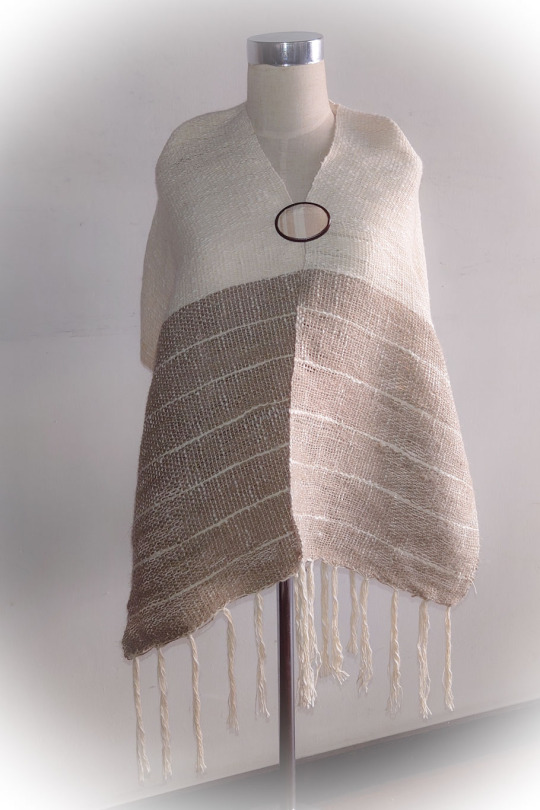
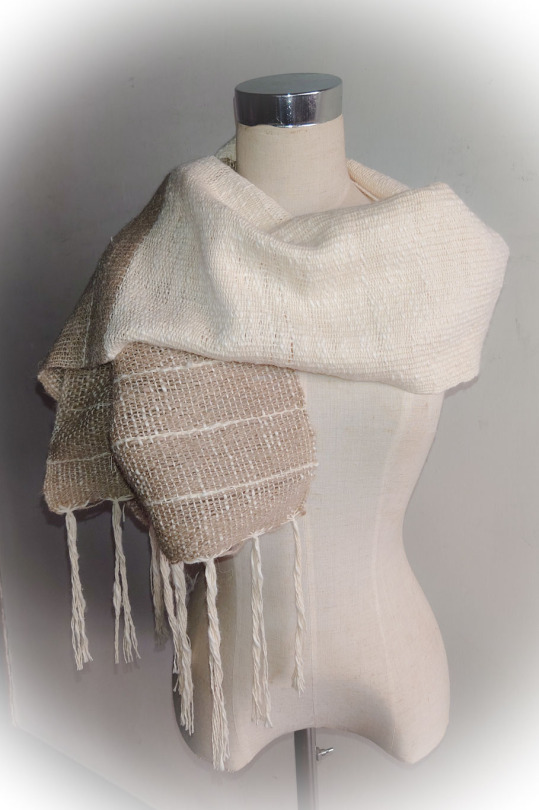
綿のスラブ糸と組み合わせて、新しいショールができました!
Combined with cotton slub yarn, I have just woven a new shawl!
300 notes
·
View notes
Text
There was some interest in a previous post on how I've been doing my selvedges on my towels. This is my first project using a 100% linen warp so I am very much not an expert, but here's a little video about what I've been doing!
A couple of things:
- This is a cottolin warp and tow linen weft. Linen yarn has almost no elasticity and has a reputation for being a really fussy warp - the cotton/linen blend gives is just a little bit of stretch and so far it's behaved beautifully. I have the tension on the warp cranked up about as high as it can go on my table loom.
- Tbh once I got used to it, I honestly really love 100% linen as a weft. It's so wiry it has virtually no draw-in, which means my woven width is essentially the same as what I have threaded through the reed, even without using a temple. Once the towel is woven and wet finished, the linen will soften a lot. Right now the fabric feels VERY starched, which is great because that structure is helping me out.
- I had to chop this down a little bit to fit Tumblr's size requirements but I'm not really saying anything useful at the cut off end. 😅
#weaving#handweaving#linen#featuring the tippy taps of my dog and the whines of my cat who doesn't want to be near my dog
97 notes
·
View notes
Text

Man finished! I rate him a solid very cute out of ten.
This guy was published as a doily insert plus edging for a linen table cloth (seen Here). The linen part was of zero interest to me so I knit him as a stand alone doily and I very much prefer him as such. Chart A (the "doily") and Chart B (the "edging") match up for knitting in the round as a single doily.
Below the read more is going to refer a lot to the charts, which I got from the amazing Ramona French. While this is the only version of the charts I've seen, looking at the Rav page it seems to also be cut into A and B charts in the same spot. It makes sense in context of the original pattern but I don't like it, both for the reason i'll get to below and also because I straight up just don't like how it looks in the original pattern.
Even without the alterations I'll propose, I think he's a good doily just as he is. The problems I have are barely noticeable/nitpicky now that he's blocked out.
Starting with the edging vs doily distinction. This problem starts with the original pattern since it has you knit chart A for the insertion and chart B for the edging around every insertion and the linen tablecloth edges. But divorcing the actual charts from the linen, the charts really should be rows 1-31 of A as the "doily" and Chart A rows 33-41 and all of chart B for the "edging". The reason I'm so specific about this is because it's focus for any changes I would make. The end of chart A and the beginning of chart B flow together perfectly. It's where the doily/center flower ends (Row 31) and the edging begins (Row 33) that is the problem spot.

(I should've picked a darker colour foam to block this out on, sorry if it's hard to see)
The large center petals (doily) end with a yo, twisted knit 1, yo at the very tip. Then the set up row for the edging is all knits with a yarn over... that is off center of the petal. In a more personal gripe, I don't like how the mesh in the flower portion looks next to the edging. It's not bad (and would probably bother me less if it weren't off center) but it's not my favourite.
The mesh not looking nice next to the edging is an easy fix that comes directly from a doily that has a very similar feel to this one. Sechsblatt is another doily I've knit and also has a 6 petaled flower with mesh between the petals and an edging, but it's edging is separated by several rows of plain stockinette. In my revised chart I added just one odd numbered row of stockinette. I'm not 100% on this change, it's something that you just can't know if it looks good until it's swatched out.
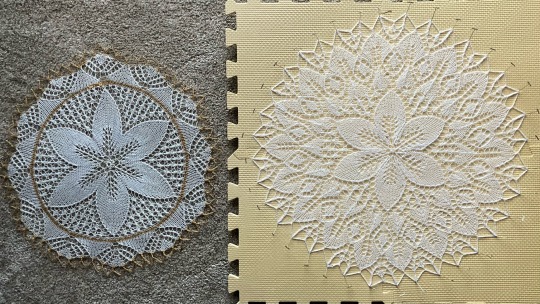
The change I am 100% on is centering the yarn over to be directly above the tip of the center flower petal. There's a number of ways to do so, I'm honestly surprised it wasn't done for the original pattern. My revised chart moves the k2tog on row 35 to directly over the center stitch of the petal, which required moving the start of the repeat one stitch left. This also needs swatched out but I'm fairly confident it'll line up, at least better that just being blatantly off center like it is in the original, and since the k2tog was just moved instead of being added, the stitch count should still work out.
All other changes to the chart were simply made for personal preference/printing convenience.

Eventually I'll knit this revised version but I don't have a timeline on that yet, knitting the same thing multiple times is bad for my attention span. Regardless I would wait because I want to see how the crochet bind off holds up. I usually pin out every chain of the crochet bind out individually but I thought pinning two together looked really good on this particular doily. It made the blocking process a lot tighter. That could've been because I accidentally stretched it too much in the first place (I forgot this doily was 6 parts instead of 8) but it was incredibly funny to behold.
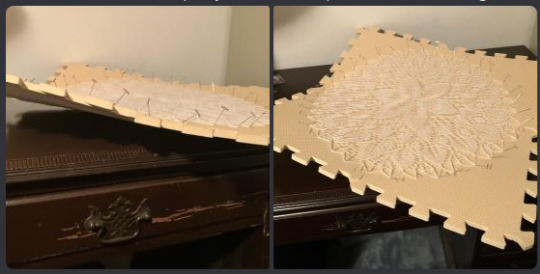
#knitting#knitblr#lace rot#lace knitting#doily#project: doily 13#he's so pretty ahhh!!#i'm minorly obsessed with his edging. i think it would look so pretty at like the edge of a skirt or cuffs or something#i'll have to come up with something to use it on that isn't so femme to make me dysphoric.#or i'll just add it to the edge of a shawl that i already don't intend to wear lmao
70 notes
·
View notes
Text
The Versatility and Elegance of Linen Yarn
Linen yarn, derived from the flax plant, is a timeless material known for its durability, breathability, and natural beauty. This Micro- blog explores the unique qualities of linen yarn, its benefits, and its various applications.

What is Linen Yarn?
Linen yarn is spun from the fibers of the flax plant, making it one of the oldest textiles in human history. Its production involves a meticulous process of harvesting, retting, and spinning, resulting in a yarn that is both strong and smooth. Linen yarn is celebrated for its natural luster and crisp texture, which only improves with age and use.
Benefits of Linen Yarn
Durability: Linen yarn is incredibly strong, making it ideal for items that require longevity. Unlike other fibers, linen becomes softer and more pliable with each wash, enhancing its comfort over time.
Breathability: One of the standout features of linen yarn is its breathability. It allows air to circulate freely, making it perfect for summer garments and accessories. This quality also helps in regulating body temperature, keeping you cool in hot weather.
Moisture-Wicking: Linen yarn has excellent moisture-wicking properties. It can absorb a significant amount of moisture without feeling damp, making it suitable for towels, dishcloths, and other household items.
Eco-Friendly: Linen is a sustainable choice. The flax plant requires minimal water and pesticides, and every part of the plant can be used, resulting in zero waste.
Applications of Linen Yarn
Linen yarn’s versatility makes it suitable for a wide range of projects:
Clothing: Linen yarn is perfect for knitting and crocheting summer tops, dresses, and lightweight sweaters. Its breathability and moisture-wicking properties ensure comfort in warm weather.
Home Textiles: From table runners to curtains, linen yarn adds a touch of elegance to home decor. Its durability ensures that these items will last for years.
Accessories: Scarves, hats, and bags made from linen yarn are not only stylish but also practical. They are lightweight, breathable, and easy to care for.
Craft Projects: Linen yarn is also popular in various craft projects, including weaving and embroidery. Its natural sheen and texture add a unique dimension to handmade items.
Caring for Linen Yarn
Taking care of linen yarn is straightforward. It can be machine washed on a gentle cycle and should be laid flat to dry to maintain its shape and texture. Over time, linen yarn becomes softer and more comfortable, making it a joy to work with and wear.
What is the Difference Between Hemp and Linen Yarn?
While both hemp and linen yarns are derived from plant fibers and share some similarities, they have distinct differences:
Source: Linen yarn comes from the flax plant, whereas hemp yarn is derived from the hemp plant.
Texture: Linen yarn is known for its smooth and crisp texture, while hemp yarn tends to be coarser and more rugged.
Strength: Both yarns are strong, but hemp is often considered more durable and resistant to wear and tear.
Environmental Impact: Both plants are eco-friendly, but hemp grows faster and requires fewer resources, making it slightly more sustainable.
Conclusion
Linen yarn is a remarkable material that combines beauty, functionality, and sustainability. Whether you’re a seasoned crafter or a beginner, incorporating linen yarn into your projects can elevate your creations with its unique qualities. Explore the wide range of linen yarn options available at Silk City Fibers and discover the endless possibilities this versatile yarn has to offer.
For more high-quality yarns and crafting supplies, visit Silk City Fibers. Their extensive collection ensures you’ll find the perfect materials for all your creative endeavors.
#linen fabric#linen yarn#cone yarn#world’s finest yarns#knitting yarn#100% linen yarn#Linen yarn cone#Linen yarn for crochet
0 notes
Text
Fiber arts update!!
First of all, some kinda bad photos of some very cool stuff I got:
(handspun by me, crocheting by my fiber arts buddy who, unlike me, can actually count to three sometimes and thus doesn't absolutely loathe crocheting)
Granny shawl: shetland/silk, shetland, merino/viscose.
I promise the colors look much better irl

Lace-y scarf: Merino/silk

also much prettier irl, and surprisingly warm!
Then, stash update:
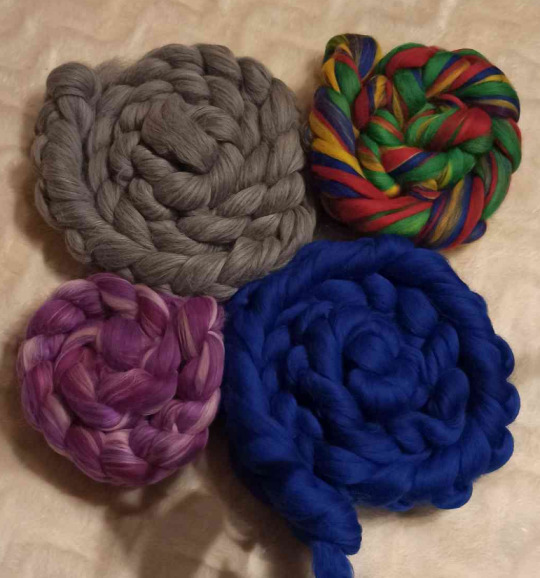
added 200g grey merino (for a hat for my lil' sis) and dark blue merino (for an acquaintance of my partner), and 100g purple/pink merino (for a headband for said partner's dad) and 100g multicolor merino (??? why not). Not shown: A full pound of "Polarfuchs"/dark grey Icelandic, and another 100g of the blue sparkle merino.
Advent calendar update, days 8-10:

linen (or, more precisely, dyed tow flax), merino (VERY GREEN), merino (VERY VERY PINK!!)
Doodad Update:
Bone needle (for soon-to-be nålbinding attempts), and a yarn gauge (it was surprisingly hard to find something that didn't have to get shipped internationally)
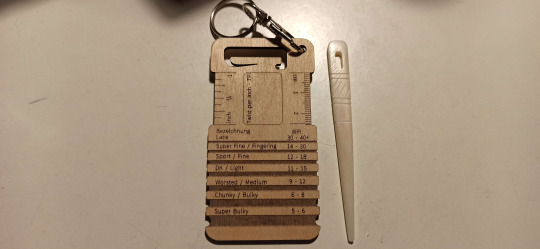
The other side of the yarn gauge can also measure twist angle.
And, last but not least, progress on my marathon christmas spin:
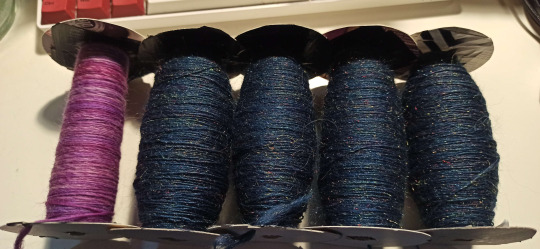
200g of blue sparkle merino singles, and 25g of pink/purple stuff. Gonna finish the other 75g of that, and then it'll be on to plying!
(bobbins are modified Ashford weaving bobbins; I know some people who use a bobbin winder and storage bobbins modify said bobbin winder to take larger-diameter bobbins, but if I have the choice to either mess with a 100$ piece of equipment or some 1$-per-piece plastic spools, I know what I'll go for)
54 notes
·
View notes
Text
#Casa fashion is one of the best 100% Linen. We have our own manufacturing unit in india for 100% Linen manufacturing and we export best qual#Grey Medium Check Fabric#Yarn Dyed Solid Fabric
0 notes
Text
made unwise yarn purchasing decisions hello everyone
#i see %100 linen yarn on clearance. i lose allc ontrol of my body#it IS an incredible deal but i just remembered customs charges u on the actual value of the product before the discount#so it may be a horrible surprise <3
1 note
·
View note
Text
@tyrninne you asked about the student I had with the pseudo-science reasons for learning to knit.
Honestly, I can't understand it very well (I have too much of a STEM background, realistically), but it boiled down to wanting 100% natural fibres for everything. So the nylon blend sock yarns were out. Which would have been less of a problem if I wasn't working at Michaels which doesn't even have 100% wool sock yarns and if she had been willing to wear wool in summer. She found a local Mennonite (presumably Plain) lady to knit her some cotton socks.
As for what her beliefs around this were (and yes, I was almost as scornful about this to her face, because she insisted in behaving as if I not only knew what she was talking about, but shared these beliefs) there was something about vibrations. I'm not sure that she knew any more specifically than that by the way, because anytime I asked for more details (I asked nicely at first, because I thought that maybe there was a kernel of something in there that had just been misinterpreted, like the seed oil nonsense that goes around these days, so I could possibly answer her questions even though I disagreed with the premise) the explanation kind of stalled out at that level. Natural stuff was better for you and processed stuff was bad for you. Worsted vs woolen spun yarn apparently didn't matter, when I told her about that.
I suspect this was the same stuff that I saw on Facebook where someone apparently had "hooked an oscilloscope" up to both wool and linen (yes, that's as much detail on what they were measuring as was originally given) and discovered that wool and linen are both amazing because they vibrate at high frequencies 5000 and negative 5000, but if you mix them then they cancel each other out and are bad for you, so the Jewish law against mixing the two was clearly a case of important divine knowledge being passed on for people's health.
#I respected that lady's version of the nonsense more#because it was vague enough that it was harder to put holes in#but the version I saw on facebook was soooo bad
12 notes
·
View notes
Text

Sample 2
Weft faced rib (2:4)
Warp: 100% cotton
Weft 1: Polyurethane coated tape yarn
Weft 2: linen-cotton blend
Idk what is it about ribs but I really like weaving them. Black yarn photographs like shit.
8 notes
·
View notes